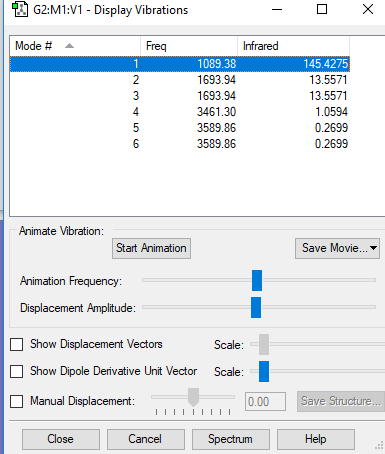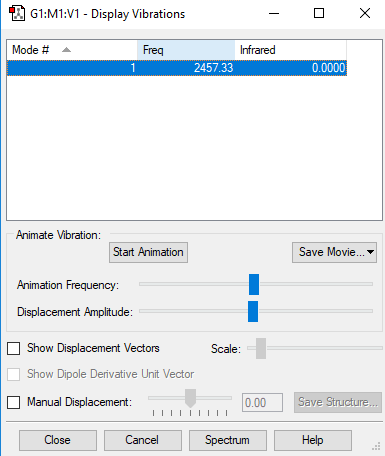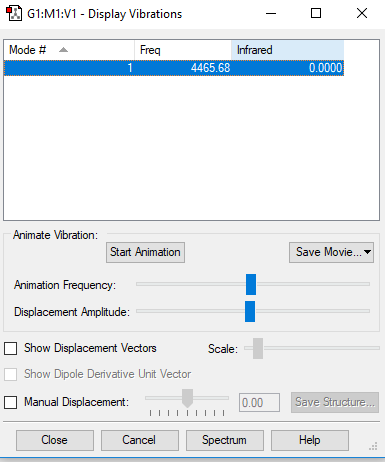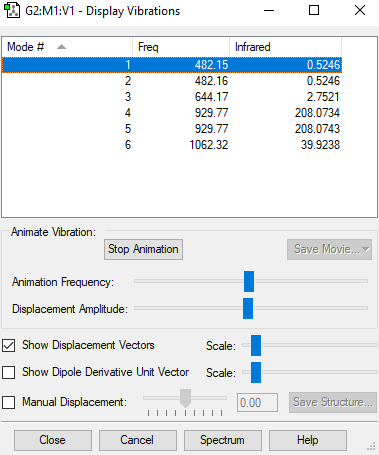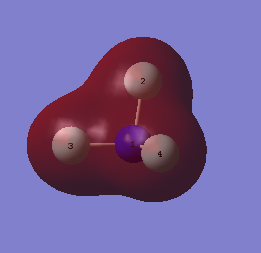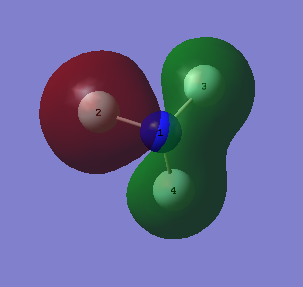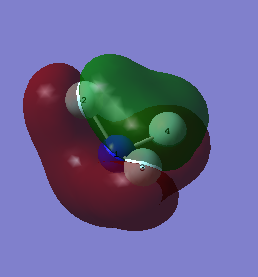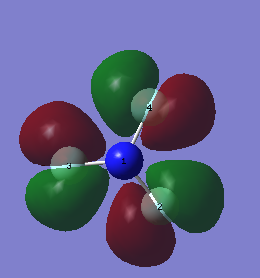User:Zl8918
NH3 molecule
Summary
N-H bond distance = 1.02Å
H-N-H bond angle = 106°
Calculation Type: FREQ
Calculation Method: RB3LYP
Basis Set: 6-31G(d,p)
Charge: 0
Spin: Singlet
E(RB3LYP): -56.55776873a.u.
RMS Gradient Norm: 0.00000323
Imaginary Freq: 0
Dipole Moment: 1.8465
Point Group: C3V
NH3 |
Optimised NH3 output
Item Value Threshold Converged? Maximum Force 0.000006 0.000450 YES RMS Force 0.000004 0.000300 YES Maximum Displacement 0.000014 0.001800 YES RMS Displacement 0.000009 0.001200 YES
Vibrations
| wavenumber cm-1 | 1089 | 1649 | 1649 | 3461 | 3590 | 3590 |
| symmetry | A1 | E | E | A1 | E | E |
| intensity (arbitrary units) | 145 | 14 | 14 | 1 | 0 | 0 |
Questions
Q: how many modes do you expect from the 3N-6 rule?
A:6
Q: which modes are degenerate (ie have the same energy)?
A:2&3 5&6
Q: which modes are "bending" vibrations and which are "bond stretch" vibrations?
A:bending vibrations: 1&2&3 bond stretch: 4&5&6
Q: which mode is highly symmetric?
A:1&4
Q:one mode is known as the "umbrella" mode, which one is this?
A:1
Q: how many bands would you expect to see in an experimental spectrum of gaseous ammonia?
A:4
Atomic charges
the charge on the N-atom is -1.125 and H-atom is +0.375
Nitrogen carry negatove charge since it is more electronegativity.
N2 molecule
Summary
N-N bond distance = 1.11Å
N-N bond angle = 180°
Calculation Type: FREQ
Calculation Method:RB3LYP
Basis Set: 6-31G(d,p)
Charge: 0
Spin: Singlet
E(RB3LYP): -109.52412868a.u.
RMS Gradient Norm: 0.00000060a.u.
Dipole Moment: 0.0000 Debye
Point Group: D*H
N2 |
Optimised N2 output
Item Value Threshold Converged? Maximum Force 0.000001 0.000450 YES RMS Force 0.000001 0.000300 YES Maximum Displacement 0.000000 0.001800 YES RMS Displacement 0.000000 0.001200 YES
Vibrations
| wavenumber cm-1 | 2457 |
| symmetry | SGG |
| intensity (arbitrary units) | 0 |
Atomic charge
0 charge on both N molecule since there are no dipole moment
H2 molecule
Summary
H-H bond distance = 0.74Å
H-H bond angle = 180°
Calculation Type: FREQ
Calculation Method: RB3LYP
Basis Set: 6-31G(d,p)
Charge: 0
Spin: Singlet
E(RB3LYP): -1.17853936a.u.
RMS Gradient Norm: 0.00000017a.u.
Imaginary Freq: 0
Dipole Momentl: 0.0000Debye
Point Group: D*H
H2 |
Optimised H2 output
Item Value Threshold Converged? Maximum Force 0.000000 0.000450 YES RMS Force 0.000000 0.000300 YES Maximum Displacement 0.000000 0.001800 YES RMS Displacement 0.000001 0.001200 YES
Vibrations
| wavenumber cm-1 | 4466 |
| symmetry | SGG |
| intensity (arbitrary units) | 0 |
Atomic charge
0 charge on both H atom since there is no dipole moment
Structure and Reactivity
MORBDZ
https://www.ccdc.cam.ac.uk/structures/Search?Ccdcid=MORBDZ&DatabaseToSearch=Published
MORBDZ N-N bond distance= 1.1001Å
The N-N triple bond distance in MORBDZ is 1.10Å whereas the N-N triple bond distance in Nirogen gas is 1.02Å. The N-N triple bond in MORBDZ is because the triple bond is delocalised with the benzene ring to form a conjugate system. So the N-N triple bond is stronger and the bond length is shorter.
E(NH3)= -56.55776873a.u.
2*E(NH3)= -113.1155375a.u.
E(N2)= -109.52412868a.u.
E(H2)= -1.17853936a.u.
3*E(H2)= -3.53561808a.u.
ΔE=2*E(NH3)-[E(N2)+3*E(H2)]=-0.0557a.u.=-146KJ/mol
NF3 molecule
Summary
N-F bond distance = 1.38Å
F-N-F bond angle = 102°
Calculation Type: FREQ
Calculation Method: RB3LYP
Basis Set: 6-31G(d,p)
Charge: 0
Spin: Singlet
E(RB3LYP): -354.07131058 a.u.
RMS Gradient Norm: 0.00010256 a.u.
Imaginary Freq: 0
Dipole Moment: 0.0961 Debye
Point Group: C3V
NF3 |
Optimised NF3 output
Item Value Threshold Converged?
Maximum Force 0.000164 0.000450 YES
RMS Force 0.000108 0.000300 YES
Maximum Displacement 0.000612 0.001800 YES
RMS Displacement 0.000296 0.001200 YES
Vibrations
| wavenumber cm-1 | 482 | 482 | 644 | 930 | 930 | 1062 |
| symmetry | E | E | A1 | E | E | A1 |
| intensity (arbitrary units) | 1 | 1 | 3 | 208 | 208 | 40 |
Questions
Q: how many modes do you expect from the 3N-6 rule?
A:6
Q: which modes are degenerate (ie have the same energy)?
A:1&2 4&5
Q: which modes are "bending" vibrations and which are "bond stretch" vibrations?
A:bending vibrations: 1&2 bond stretch: 3&4&5&6
Q: which mode is highly symmetric?
A:2&3&6
Q: how many bands would you expect to see in an experimental spectrum of gaseous NF3?
A:4
Atomic charges
the charge on the N-atom is +0.660 and H-atom is -0.220
F carry negatove charge since it is more electronegativity.
Molecular orbitals
The HOMO of NF3 is 17 and its energy is 0.01947a.u. The LUMO of NF3 is 18 and the energy is -0.35162a.u.
Marking
Note: All grades and comments are provisional and subjecct to change until your grades are officially returned via blackboard. Please do not contact anyone about anything to do with the marking of this lab until you have recieved your grade from blackboard.
Wiki structure and presentation 1/1
Is your wiki page clear and easy to follow, with consistent formatting?
YES
Do you effectively use tables, figures and subheadings to communicate your work?
YES
NH3 0.5/1
Have you completed the calculation and given a link to the file?
YES
Have you included summary and item tables in your wiki?
YES
Have you included a 3d jmol file or an image of the finished structure?
YES
Have you included the bond lengths and angles asked for?
YES
Have you included the “display vibrations” table?
YES
Have you added a table to your wiki listing the wavenumber and intensity of each vibration?
YES
Did you do the optional extra of adding images of the vibrations?
YES
Have you included answers to the questions about vibrations and charges in the lab script?
YES - you stated to expect 4 bands in the experimental spectrum without an explanation. You correctly stated that there are two sets of degenerate modes - this explains a spectrum with 4 peaks. However there are only 2 peaks visible as peaks 4, 5 and 6 are of too low an intensity to be visible.
N2 and H2 0/0.5
Have you completed the calculations and included all relevant information? (summary, item table, structural information, jmol image, vibrations and charges)
YES - however, you stated a bond angle for diatomic molecules. To define a bond angle a minimum of 3 atoms is needed! You could have explained that the charges are 0 as the electronegativities are equal.
Crystal structure comparison 0.5/0.5
Have you included a link to a structure from the CCDC that includes a coordinated N2 or H2 molecule?
YES - however the task was to compare your results with crystal structure data and not with an organic diazonium salt.
Have you compared your optimised bond distance to the crystal structure bond distance?
YES
Haber-Bosch reaction energy calculation 0.5/1
Have you correctly calculated the energies asked for? ΔE=2*E(NH3)-[E(N2)+3*E(H2)]
YES
Have you reported your answers to the correct number of decimal places?
YES
Do your energies have the correct +/- sign?
YES
Have you answered the question, Identify which is more stable the gaseous reactants or the ammonia product?
NO - you missed to interpret the value of the calculated reaction energy.
Your choice of small molecule 3.5/5
Have you completed the calculation and included all relevant information?
YES
Have you added information about MOs and charges on atoms?
You have done a good job of presenting this information, well done! You missed to comment on the energies of the MOs and on their occupied/unoccupied state. your description of bonding/anti-bonding/non-bonding orbitals is wrong. The very same MO cannot be bonding and anti-bonding a the same time. A node is not necessarily indicative for a anti-bonding orbital (e.g. is a true bonding orbital). You statements about the contributing Mos is missing the principal quantum number to make your discussion easier to follow.
Independence 0/1
If you have finished everything else and have spare time in the lab you could: Check one of your results against the literature, or Do an extra calculation on another small molecule, or Do some deeper analysis on your results so far
NO - No independent work has been identified.

